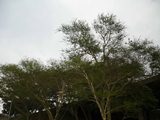Weaver news
| Stevens MC, Ottosson U, McGregor R, Brandt M, Cresswell W. 2013. Survival rates in West African savanna birds. Ostrich 84: 11-25 Abstract. Despite widespread interest in life histories and the comparison of parameters between tropical and temperate regions, there are still relatively few multispecies studies assessing annual survival in Afrotropical species. We used data from systematic mist-netting of savanna birds in Nigeria, between 2001 and 2008, to estimate survival for 40 Afrotropical bird species. Best-supported models were those incorporating constant survival (27 of 40) or the effects of transience (13 of 40). Survival ranged from 0.269 to 0.948 (mean +- SE = 0.64 +- 0.02), varied within and between families, and showed a positive relationship with mass in passerines. Survival was highest in the insectivorous Malaconotidae (0.79 +- 0.13) and lowest in the granivorous Estrildinae (0.51 +- 0.04). This pattern was also evident in a comparison of survival between guilds (highest in insectivores and lowest in granivores) suggesting that these species encounter seasonal starvation risks or exhibit a seasonal response to water availability, i.e. emigration from the study area leading to reduced site fidelity and lower apparent survival. Our estimates of adult survival are higher than those previously obtained from this site, comparable with those from other Afrotropical studies (i.e. >0.60) and higher than those from temperate zones (0.53 +- 0.01, n = 79).
The study was conducted within the Amurum Forest Reserve (AFR) on the Jos Plateau, Nigeria (09 52N, 08 58E). Mist nets were used between 6h00 and 10h30 at five locations across the reserve. A total of 14 524 captures of 10 950 individuals of 161 Afrotropical species were made at AFR. The survival rates for weavers in this study was:
See a list of papers from APLORI, the A. P. Leventis Ornithological Research Institute here. Literature as featured in Weaver Watch news items |











